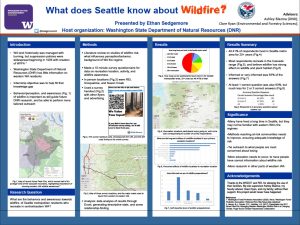Examination Of Western Washington Residents’ Behaviors, Perceptions, And Awareness Of Wildfire
The Washington Department of Natural Resources (DNR) does not have baseline data of behaviors, perceptions, or awareness of western Washington (WA) residents regarding wildfire. To effectively perform outreach, circulate educational materials, and conduct research, this knowledge gap must be filled. This study’s purpose was to choose a pilot area to develop some of this baseline data. For this project, our team created and administered a survey to Seattle metropolitan residents who frequently recreate in central or eastern WA, choosing that population because people within frequently move between different fire regimes, and they may bring awareness, perceptions, and behaviors of eastern WA over to western WA. Alongside the survey, I conducted a literature review of similar studies. Survey results show that most respondents (63.2%) indicated they were informed or very informed of wildfire risks; however fewer respondents (46.91%) correctly answered the wildfire knowledge questions. This discrepancy indicates the WADNR must focus more on wildfire-risk education. Being more aware and active in recreation can give people the chance to help prevent fires. Additionally, about half of respondents (54.7%) have experienced wildfire, and most respondents feel that a wildfire within a few miles (89.2%) or within a mile (87.9%) of their recreation site would adversely affect their recreation ability. This study only identified baseline information, so more focused analysis is needed for specific community behaviors and perceptions of wildfire. Finally, this study only considered the Seattle metropolitan area, so other studies in western WA, especially within the Wildland-Urban Interface (WUI), should be conducted.
